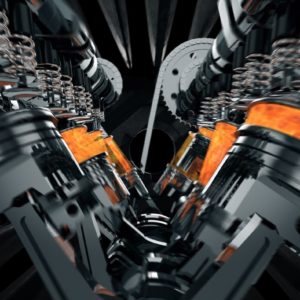A cylinder misfire is a common problem that can happen for a variety of reasons. When your car starts misfiring, you’ll likely notice engine performance problems, such as rough running and hesitation. The check engine light will usually illuminate, as well.
Not only does a misfire make your car unpleasant (and sometimes unsafe) to drive, but it can also cause additional damage to your vehicle. So, you’ll definitely want to diagnose and repair the problem right away.

What is a Cylinder Misfire?
To understand a misfire, it helps to first have knowledge of how a gasoline engine creates energy by compressing and igniting an air-fuel mixture.
When the engine is running, a series of valves allow air (and fuel in the case of port injection) to enter each cylinder in sequence. After air and fuel have been pulled into one of the cylinders, the valves close and the piston moves upward in that cylinder to pressurize (compress) the mixture.
Next, the spark plug fires and the air-fuel mixture is ignited. The explosion (combustion) forces the piston downward, causing the crankshaft to turn. The process is repeated in each of the engine’s cylinders to create the rotational force needed to propel your vehicle down the road.
A misfire occurs when there’s incomplete (or zero) combustion taking place inside one of the engine’s cylinders. On a modern car, the problem will almost always trigger the check engine light. You might also notice that the engine runs rough, hesitates, or lacks power (or suffers from all three issues).
What Causes a Cylinder Misfire? Common Causes
An engine needs three primary ingredients to run properly: a precise air-fuel mixture, adequate spark, and good compression. When one or more of these factors are missing, incomplete combustion occurs, resulting in a misfire.
There are many potential engine misfire causes. Here are some of the most common:

Ignition System Problems
Ignition system problems that result in inadequate or improperly timed spark cause an engine misfire. Some examples include:
Air-fuel Mixture Issues
Any problem that throws off the engine’s air-fuel mixture can result in a misfire. Some examples include:
- Vacuum leaks (allowing unmetered air to enter the engine)
- Faulty fuel pump
- Bad or dirty fuel injectors
- Failed fuel pressure regulator
- Clogged fuel filter

Engine Mechanical Problems
A variety of engine mechanical problems can result in a loss of compression, causing a misfire. Some examples include:
- Worn pistons, rings, or cylinder walls
- Blown head gasket
- Damaged valves and valvetrain components
- Worn timing belt or timing chain
Sensor and Module Issues
Your car’s engine computer, which is often referred to as the powertrain control module (PCM), receives input from a wide range of sensors. The module then uses that information when deciding how to operate output devices, such as the ignition coils and fuel injectors.
Many of the sensors the PCM relies on can cause a misfire when they fail. The module itself can also cause a misfire if it has an internal failure, such as a bad coil or injector driver. Some examples of sensor and module issues include:
- Bad sensor (e.g., mass airflow or crankshaft position sensor)
- A PCM hardware or software failure
- Circuit issues, such as damaged wires and poor connections

Other Systems Failures
But wait—that’s not all. Modern vehicles are fitted with other engine-related equipment that can lead to a misfire when it fails. Some examples include:
- Exhaust gas recirculation (EGR) system problems
- Cylinder deactivation system problems
- Variable valve timing system problems
- Secondary air injection (SAI) system problems
FAQ
A misfire can eventually damage the catalytic converter and possibly even the engine itself. As such, you’ll want to diagnose and repair the problem right away.
Diagnosing a misfire can be difficult, especially if the problem is occurring on more than one cylinder. If you’re not particularly confident in your troubleshooting skills, you might want to leave the job to a professional. Otherwise, you can check out the videos below for an idea of what the diagnostic process might involve:
Other Notes About Cylinder Misfire
There are several related OBD-II codes to the cylinder misfire:
- P0300 Random/Multiple Cylinder Misfire Detected
- P0301 Cylinder 1 Misfire Detected
- P0302 Cylinder 2 Misfire Detected
- P0303 Cylinder 3 Misfire Detected
- P0304 Cylinder 4 Misfire Detected
- P0305 Cylinder 5 Misfire Detected
- P0306 Cylinder 6 Misfire Detected
- P0307 Cylinder 7 Misfire Detected
- P0308 Cylinder 8 Misfire Detected
- P0309 Cylinder 9 Misfire Detected
- P0310 Cylinder 10 Misfire Detected
- P0311 Cylinder 11 Misfire Detected
- P0312 Cylinder 12 Misfire Detected
- P0313 Misfire Detected With Low Fuel
- P0314 Single Cylinder Misfire (Cylinder not Specified)
- P0316 Engine Misfire Detected on Startup (First 1000 Revolutions)
- P0363 Misfire Detected – Fueling Disabled
Get High-Quality Engine Parts For Your Vehicle
You shouldn’t ignore engine problems like cylinder misfires because they can cause issues that can make your vehicle undrivable. Moreover, misfires can cause more engine damage, which can get expensive to repair. Good thing you don’t have to delay your repair since getting parts here at CarParts.com is quick and easy.
CarParts.com is a trusted source of high-quality and affordable aftermarket parts. Our engine components like head gaskets, pistons, and timing belts are sourced from only the leading aftermarket brands. You can easily browse through our catalog using our vehicle selector and search filters. Order by 12 p.m ET., and you can expect your new part to get to your doorstep in as fast as two business days.
Don’t wait until some engine components break before replacing them. Check out our selection of engine components like head gaskets, pistons, and timing belts and shop today!
Any information provided on this Website is for informational purposes only and is not intended to replace consultation with a professional mechanic. The accuracy and timeliness of the information may change from the time of publication.





























